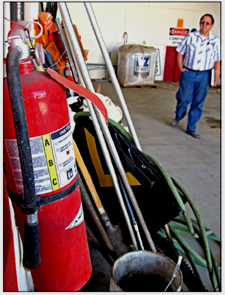
| CONNECTIONS |
IDAHO
ITD
HOME
511 TRAVEL SERVICES
IDAHO
DMV
ITD
NEWS
HIGHWAY
SAFETY
IDAHO STATE POLICE
STATE OF IDAHO
NIATT
NATIONAL
AASHTO
AAMVA
AAA of IDAHO
FEDERAL HIGHWAYS
FEDERAL AVIATION
IDAHO STATE POLICE
NHTSA
NTSB
TRB
U.S. DOT
TRANSPORTER
Archives
Milestones
Comments
Idaho
Transportation
Department
Office of Communications
P.O. Box 7129
Boise, ID 83707
208.334.8005
Fax: 208.334.8563

District
4 inspections ensure safe working conditions
What’s the point of having a rolling television cart if the wheels should be taken off?
That’s the question District 4 EST Randy Norris asked the Idaho Division of Building Safety inspector Mike Poulin on Aug. 21. The simple answer was it was a safety hazard. Little things like rust on pipes, checking emergency lights and looking for tripping hazards are only a few things Poulin looks for in each of the state-owned buildings in District 4 and around the state.
“It sounds simple, but it’s not,” Poulin said about his inspection process. “We’re looking for those things to improve employee safety and public safety in all the buildings.”
 Many
of the simple things, Poulin said, people generally do not think about
or use commonly around their homes. Improper use of extension cords,
unanchored book shelves and filing or storage cabinets, obstructed electrical
panels, safety guards are only a few of the dozens of items which can
be seen as safety hazard that are among the many items ignored.
Many
of the simple things, Poulin said, people generally do not think about
or use commonly around their homes. Improper use of extension cords,
unanchored book shelves and filing or storage cabinets, obstructed electrical
panels, safety guards are only a few of the dozens of items which can
be seen as safety hazard that are among the many items ignored.
However, the standards are higher on state property.
“Nobody can regulate what you do at home,” Poulin said using gasoline as an example. “You can put it (gasoline) in a glass jug if you want at home. Just not at a gas station The state requires we put gas in metal cans because if a fire begins with gasoline in a plastic container it will melt and spread the gas on the floor and spread the fire, he said.
“In a metal container, it gets really hot but will contain the fire.”
Norris said in District 4, the crews in the maintenance sheds do a good job of policing themselves with monthly inspections, but not all crews keep up a consistent review of facilities and report it to the district safety committee.
“(The safety committee) mostly tracks damages to buildings, injuries and ideas about tracking safety issues,” Norris said.
In addition to employee and pubic safety, the inspections also aid in limiting the number of tort and worker compensation claims filed against the state of Idaho.
The Division of Building Safety also is charged with inspecting schools and rest areas which, Poulin said, are completely different because the public has primary access to those areas.
In the end, however, the Division of Building Safety does not levy fines against state departments like ITD, but only gives recommendations. From there it is up to the employees to make sure those safety hazards get fixed.
Looking through schools and state-owned buildings throughout the state, Poulin said he has found a number of odd things – some safety violations, some legal and some that didn’t fit into normal categories.
However, when asked what the most strange or funny thing he has come across while doing an inspection was a methamphetamine lab.
“It was in a small, little used room,” Pouli said. “It surprised more than just me.”
Though Poulin would not disclose when or where he found the meth cooker, he said it was being maintained by a state employee.
Published 9-21-07